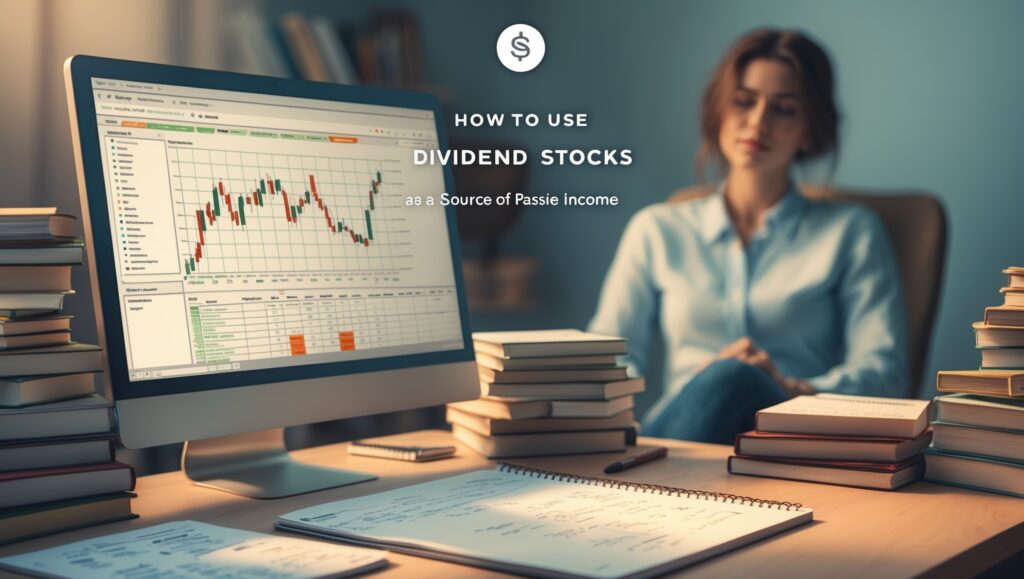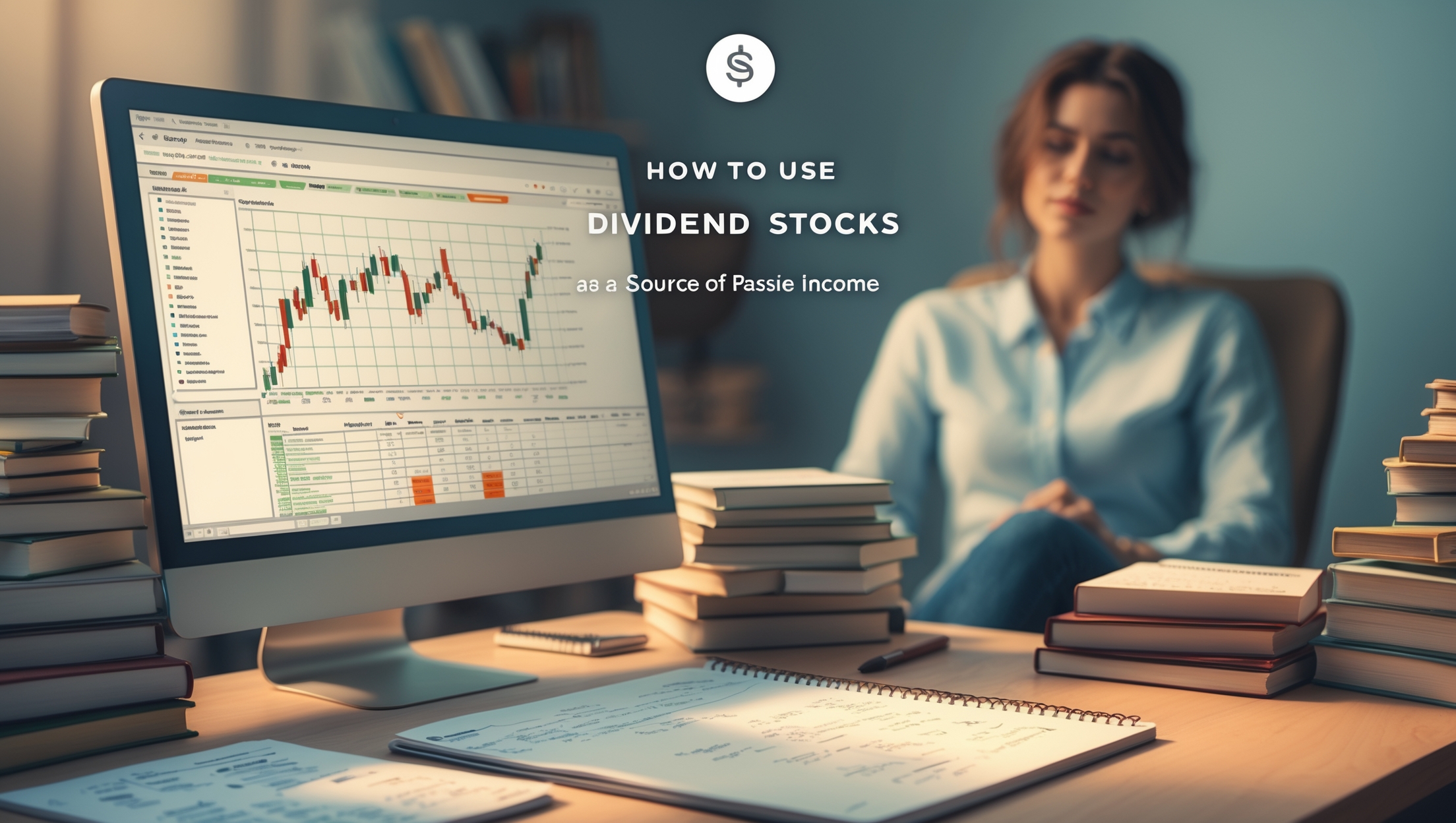How to Use Dividend Stocks as a Source of Passive Income
How to Use Dividend Stocks as a Source of Passive Income
Learn how to use dividend stocks as a source of passive income. I’ll explain how I personally select dividend-paying stocks, reinvest profits, and build a steady cash flow that can supplement or even cover bills.

Table of Contents
When I first started investing, I didn’t pay much attention to dividends. I was focused solely on capital gains. But over time, I realized that dividends are a powerful way to earn income while keeping your principal invested.
Dividend stocks are shares of companies that pay a portion of their profits back to shareholders, usually quarterly. For me, this is like getting a paycheck for simply owning stock—without selling anything.
Why I Use Dividend Stocks
I use dividend stocks because they create a reliable income stream. Even when the stock price fluctuates, I still receive dividends as long as the company continues paying. It’s a strategy that has given me confidence during market volatility.
Plus, reinvesting dividends compounds wealth over time. I’ve seen my portfolio grow faster simply by taking the payouts and buying more shares regularly.
How to Find Good Dividend Stocks
Not all dividend stocks are created equal. I focus on:
- Dividend yield – The percentage of the stock price paid annually.
- Dividend growth – Companies that consistently raise dividends are ideal.
- Financial stability – Strong balance sheets reduce the risk of dividend cuts.
I personally use ETFs and individual stocks to diversify my dividend holdings, which reduces risk while still providing reliable payouts.
Reinvesting Dividends for Growth
One strategy I use is automatic dividend reinvestment. Every time a company pays me a dividend, I buy more shares. Over the years, this has significantly increased both my income and my overall portfolio value.
It’s like letting your money work for you on autopilot. Even small dividends can snowball into substantial gains over time.
Balancing Dividend Stocks in Your Portfolio
I don’t put all my money into dividend stocks. I balance them with growth stocks, ETFs, and sometimes low-volatility assets. This combination allows me to enjoy income from dividends while still benefiting from capital appreciation.
It’s all about creating a stable, diversified portfolio that can generate passive income without taking excessive risk.
My Favorite Dividend Sectors
Over time, I’ve learned certain sectors tend to pay reliable dividends:
- Utilities – Steady demand makes dividends consistent.
- Consumer staples – Products people buy every day ensure revenue stability.
- Healthcare – Aging populations support long-term growth and payouts.
- Real estate investment trusts (REITs) – Often pay higher dividends but require careful selection.
By focusing on these sectors, I reduce the chance of dividend cuts while keeping income flowing.
Tracking and Monitoring Dividends
I keep a spreadsheet of my dividend-paying stocks, tracking yields, payout dates, and growth trends. This helps me spot opportunities and make adjustments when necessary.
For example, if a company hasn’t increased its dividend in years, I might consider reallocating to a stronger performer.
Tax Considerations
Dividends are taxable, so I make sure to account for taxes when planning my income. I also use tax-advantaged accounts, like IRAs, whenever possible to let dividends grow tax-deferred.
Planning for taxes ensures that the income I generate is truly passive and profitable.
Want My Complete Dividend Strategy?
If you want to see exactly how I use dividend stocks to generate consistent income, I cover everything in my ebook: Pay Bills with Stocks.
Inside, I break down my exact process for picking dividend stocks, reinvesting dividends, and structuring a portfolio that generates real, usable income every month.
Final Thoughts
Dividend stocks are one of the most reliable ways to earn passive income while keeping your money invested. By choosing stable companies, reinvesting payouts, and monitoring growth, I’ve built a system that provides both income and long-term wealth.
If you’re looking to create a portfolio that pays you while you sleep, dividend investing is a strategy I personally rely on—and it’s one I highly recommend.
Check out my guide to see how I turn dividend stocks into a monthly income system: Pay Bills with Stocks.
One of the first lessons I learned with dividend investing is that patience is key. Dividends don’t make you rich overnight, but over time they can create a reliable stream of income that grows steadily.
I also focus on companies with a history of dividend growth. A company that increases its payout every year shows stability and commitment to shareholders. This is the kind of consistency I want in my portfolio.
Another tip I follow is to avoid chasing the highest dividend yields blindly. Sometimes a very high yield is a warning sign that the company is struggling. I prioritize sustainable, realistic yields over flashy numbers.
I personally diversify across sectors to reduce risk. Utilities, consumer staples, and healthcare are my go-to sectors because they tend to pay dividends even during market downturns. Diversification helps me sleep better at night.
Tracking ex-dividend dates is another small step that has helped me optimize my income. By knowing when dividends are paid, I can plan reinvestments and even take advantage of compounding more effectively.
I also reinvest dividends automatically. This simple habit has accelerated my portfolio growth significantly. Even small payouts, when reinvested consistently, turn into meaningful income over time.
For me, dividend stocks are not just about income—they’re about building a long-term foundation. They provide stability and confidence, which is especially important when the market is volatile.
I’ve learned to combine dividend stocks with growth stocks for a balanced approach. Growth stocks offer upside potential, while dividend stocks give me predictable cash flow. Together, they make a portfolio that is both exciting and safe.
One strategy I use is dollar-cost averaging into dividend ETFs. This allows me to steadily build my holdings without worrying about short-term market swings. Over time, it smooths out entry prices and keeps me consistent.
I always pay attention to payout ratios. A company that pays out too much of its earnings as dividends may struggle to maintain payments. I look for ratios that indicate sustainability, which protects my income stream.
I also track the total return of dividend stocks, not just the yield. This includes capital appreciation plus dividends. Focusing only on yield can be misleading, while total return shows the real value of the investment.
Another advantage of dividend investing is compounding in action. Reinvested dividends buy more shares, which generate more dividends. Over years, this cycle grows income exponentially. I’ve seen my portfolio grow much faster using this approach.
Low-volatility dividend stocks are my personal favorite. They combine stability with income, making them ideal for reducing risk while building cash flow. I avoid high-risk, speculative dividend plays that can cut payouts suddenly.
I also diversify geographically when possible. International dividend stocks or ETFs can provide additional stability and open opportunities in markets with different economic cycles.
If you want to see how I structure a dividend portfolio that actually pays real bills, I share my full system in my ebook: Pay Bills with Stocks. It’s the exact method I use to generate monthly income from dividends while keeping my capital invested.
Finally, dividend stocks aren’t just for seasoned investors. Even beginners can start small, reinvest, and gradually build a portfolio that produces passive, reliable income. It’s a strategy I personally rely on, and it’s worked for me year after year.

Stay ahead in the stock market! Subscribe to our newsletter and receive exclusive stock flow reports, trading insights, and actionable tips directly in your inbox. Join thousands of traders who get our updates first.







